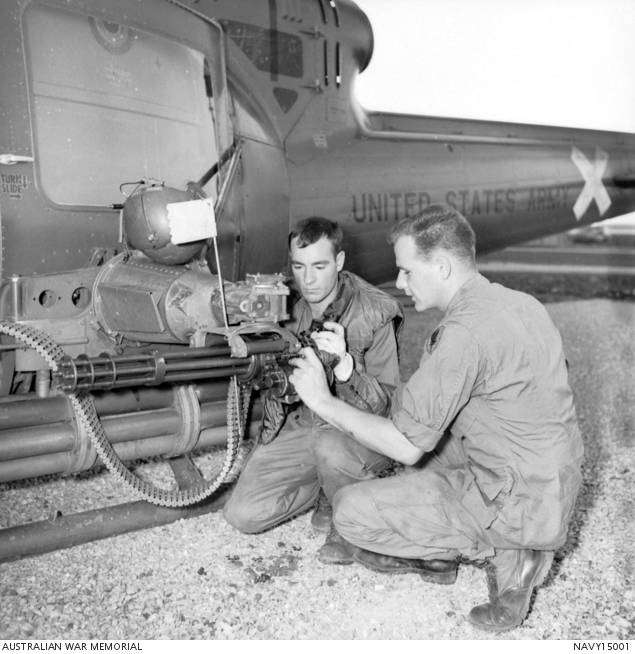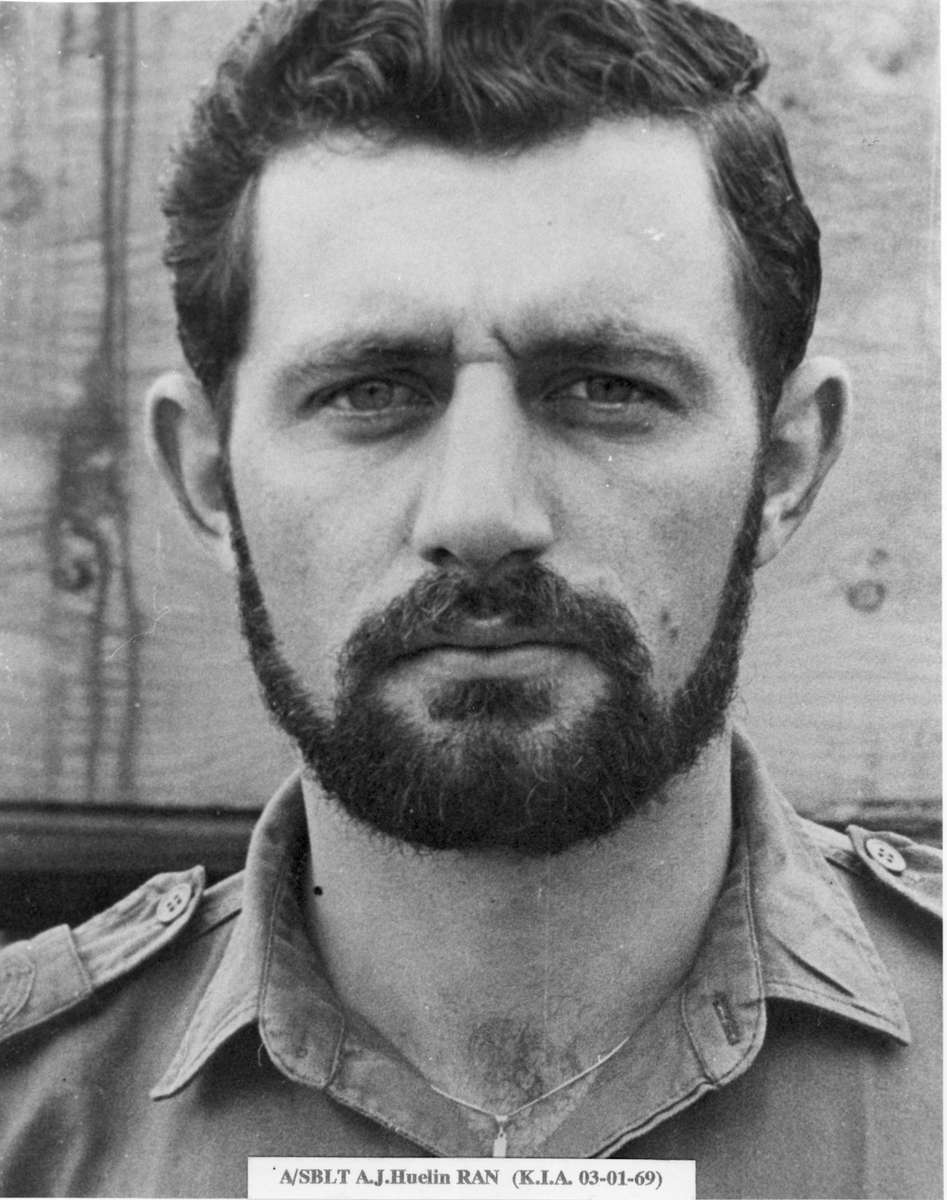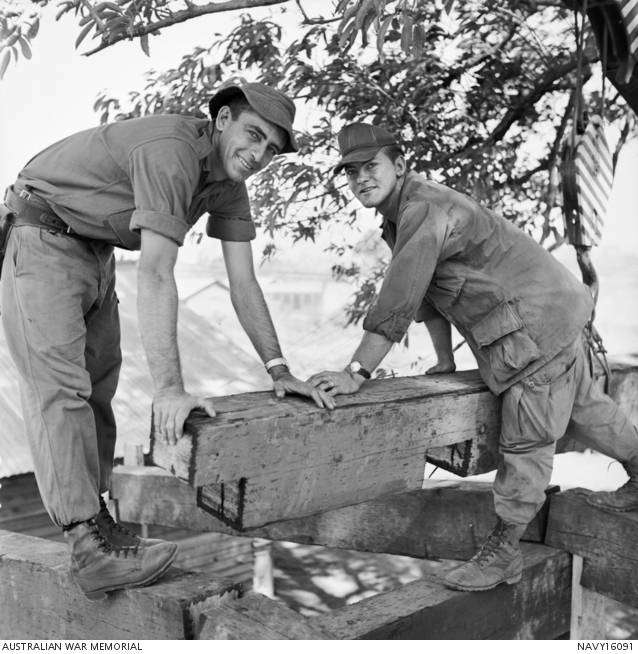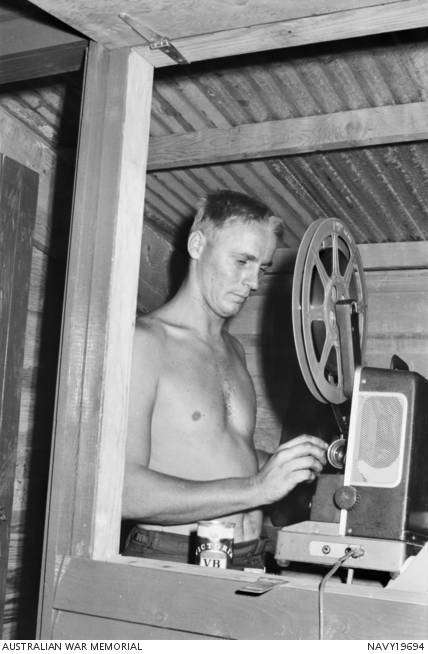Five members of the RAN Helicopter Flight Vietnam lost their lives in action, and many more were wounded. This page remembers them.
Any further information or photographs of those lost or wounded in Vietnam would be appreciated.
Return to RANHFV Heritage Page: Return
Lieutenant Commander Patrick John Vickers, RAN 22 February 1968
 On February 20, EMU helicopters assisted the 1st Australian Task Force in Operation Clayton, a cordon and search of the village of long Dien near Dat Do on Highway 23 in Phuoc Tut province. Two days later LCDR Vickers was fatally wounded while piloting the lead aircraft in a mission to lift out troops of the 18th Army of the Republic of Vietnam (ARVN) Division near Xuan Loc. Descending to the pick up zone, his aircraft was hit by enemy fire and LCDR Vickers was wounded. The co-pilot immediately flew the helicopter to Blackhorse, landing on the hospital pad within five minutes. Notwithstanding this prompt action LCDR Vickers died without regaining consciousness.
On February 20, EMU helicopters assisted the 1st Australian Task Force in Operation Clayton, a cordon and search of the village of long Dien near Dat Do on Highway 23 in Phuoc Tut province. Two days later LCDR Vickers was fatally wounded while piloting the lead aircraft in a mission to lift out troops of the 18th Army of the Republic of Vietnam (ARVN) Division near Xuan Loc. Descending to the pick up zone, his aircraft was hit by enemy fire and LCDR Vickers was wounded. The co-pilot immediately flew the helicopter to Blackhorse, landing on the hospital pad within five minutes. Notwithstanding this prompt action LCDR Vickers died without regaining consciousness.
Patrick John Vickers (1935-1968), naval officer, was born on 28 June 1935 in Brisbane. At the age of 8 he was adopted by Frank Vickers, foreman, and his wife Annie Agnes, née Cornhill, both Queenslanders. Pat was a good student at Nambour High School, and also at Gatton Agricultural High School and College where he obtained diplomas in agriculture (1952), animal husbandry (1953) and horticulture (1954). After attending the Teachers’ Training College, Brisbane, he taught at Gatton (1953-54) then at Warwick High School (1955). He also studied part time at the University of Queensland (B.Com., 1964). On 6 January 1956 he joined the Royal Australian Navy for aircrew training. Achieving a ‘special distinction in ground subjects’, he graduated as a pilot in May 1957. That month he was promoted acting sub-lieutenant and granted a short-service commission. Following operational flying training at the Naval Air Station, Nowra, New South Wales, he qualified on 20 December 1957 as a fighter-pilot in Sea Fury aircraft.
In March 1959 Vickers was promoted lieutenant. Having learned to fly jet aircraft in all weathers, he was posted in July to No.805 Squadron which operated Sea Venoms from the Naval Air Station and periodically from the aircraft-carrier H.M.A.S. Melbourne. Vickers accepted a permanent commission in 1961. Switching to helicopters, he was sent to Britain where he completed a helicopter flying-instructor’s course then spent two years (1962-64) on exchange with the Royal Navy, gaining experience and training other pilots. He became very proficient at both flying and teaching.
Returning to Australia, Vickers served at Nowra and at sea in Melbourne. He made frequent rescue flights from the naval air station. On the night of 20/21 May 1966 he searched fruitlessly for survivors after the dredge W. D. Atlas sank off Jervis Bay. Next morning he tried again and plucked from huge seas two of only four crewmen saved; thirteen others died. On 22 March 1967 he was promoted lieutenant commander. Later that year he helped to form the R.A.N. Helicopter Flight Vietnam. Consisting of eight pilots, four observers and support staff, the R.A.N.H.F.V. joined the United States Army’s 135th Assault Helicopter Company at Vung Tau, Republic of Vietnam (South Vietnam), in October.
Vickers was assigned as commander of the company’s 1st Platoon, responsible for twenty-two pilots and eleven new Iroquois UH-1H aircraft. He was also appointed senior instructor-pilot of the 222nd Combat Aviation Battalion, of which the 135th A.H.C. formed part. The company began operational flying at an intense rate. On 19 December 1967 Vickers led his platoon, with U.S. Army troops on board, against a battalion of the People’s Liberation Armed Forces (Viet Cong) which was well dug in, near Long Binh. The action continued late into the night and featured Vickers’ platoon flying in and out of the contact zone, landing reinforcements and recovering the wounded. Artillery units and helicopter gunships gave covering fire but the troop-carriers still faced grave risks. For his leadership throughout the engagement, Vickers was recommended for both American and Australian bravery awards.
The 135th A.H.C. moved to the American Black Horse base, south of Xuan Loc, in December 1967. While Vickers’ helicopters were landing soldiers near My Tho on 8 February 1968, they met a hail of fire from the ground at the critical moment of troop-disembarkation. One aircraft was destroyed and seven of the remaining eight were damaged. Again, Vickers displayed courage and determination as platoon commander. On 22 February 1968 he was descending to land near Xuan Loc when his aircraft, leading the fleet of eleven helicopters, came under small-arms fire and he was hit in the head. His co-pilot immediately flew to the hospital pad at Black Horse, but Vickers died that day and was cremated. One of the R.A.N.’s most accomplished aviators and widely respected, he was posthumously mentioned in dispatches.
His remains are interred at Everest Cemetery, Buderim, QLD.
Lieutenant Anthony Austin Casadio, RAN 21 August 1968
 O2361 Lieutenant Anthony Austin Casadio, Age 22
O2361 Lieutenant Anthony Austin Casadio, Age 22
DOB: Dec 30 1945
Port Lincoln, SA
Lieutenant Casadio was a member of the Air Training Corps for 2 ½ years and was a flight Sergeant. In January, 1963, he topped the ATC senior NCO course at Edinburgh Airfield.Lieutenant Casadio passed his final test on Vampire jet aircraft at the Advanced Flying Training School at the RAAF Base, Pearce, WA. His graduation ceremony was on March 3, 1966. Shortly afterwards he was promoted to Acting Sub-Lieutenant. Early in 1967 he was posted from Nowra Naval Air Station to HMAS Melbourne as a pilot. He was next posted to HMAS Sydney and trained as a helicopter pilot.
“On that particular day, I was in the chopper astern…just the two gunnies setting out for Nui Dat re a standby (though I have recorded 7 hours flight for the day). I was sitting with M60 cradled at my midriff, right foot on the rocket pods, with my eyes fixed on those two white stripes going in circles on the top of Casadio’s blades, when I noticed the blades start to slow down and the chopper start to descend. We were slightly higher than Casadio’s chopper and astern at a distance of some two or three cricket pitches. There was a clear space to the right [in] which Casadio attempted to set down. To me, the whole area wasn’t much bigger than a football field and there were some trees, though they were sparse. The cry “Mayday” I heard several times before the crash. I do not recall any trees being struck by the craft during the time I watched. I am probably wrong here, but I still believe the craft ended upside down in an old bomb crater. Shortly after flames erupted and explosions occurred. That’s how it appeared to me while I witnessed the event.”
Petty Officer O’Brian Cedric Ignatius Phillips, RAN 21 August 1968
O’Brian Cedric Phillips was born in Patna, India, of British and Indian heritage. He joined the RAN in 1960 and served as a sonar operator in Wessex helicopters before being posted to the first contingent of the RANHFV in 1967.
In December 1967 the Unit moved from the increasingly crowded base at Vung Tau to the American Black Horse fire support base her Xuan Loc. As second in command of the working party that expanded Black Horse to accommodate the Emus, Phillips showed ingenuity; he also served as a pathfinder attached to Australian Army Infantry Units. He participated enough patrols to entice him to the Army’s Infantry Combat Badge, a unique honour among naval aviators in Vietnam.
On 21 August 1968 Phillips was a door gunner in the lead helicopter of a light fire team of gunships. Flying at treetop height from Black Horse to Hui Dat, the helicopter crashed into a clearing with the loss of all four personnel on board, including fellow Australian LEUT Casadio, and Americans WO Hershel Bullock and Specialist 4 William Fennell. The crash was attributed to enemy fire, as detailed above.
The loss of the four men was keenly felt among the close-knit EUM contingent at Black Horse, who held a memorial service at the Base. Phillips was just 32 years old and was survived by his wife Margaret. He is buried at the Karrkatta Cemetery in Perth.
Image:R56859 POACM O’Brian Cedric Phillips, of Bassendean, WA (left) and an unidentified serviceman (probably from the US Army), building the Command Bunker, probably at Fire Support Base Black Horse, South Vietnam. Words courtesy of Thomas Rogers, Historian Military History Section of the Australian War Memorial.
Acting Sub-Lieutenant Antony Jeffrey Huelin, RAN 3 January 1969
 1969 commenced badly for the 135th when, on 3 January, a helicopter captained by SBLT Antony Huelin, RAN crashed after striking power lines near Saigon. The mission involved flying from Bearcat to the Seven Mountains area, Chau Doc Province, a distance of about 140 miles. Low cloud and fog conditions were prevailing at the time, but because of the importance of the mission SBLT Huelin was unwilling to abandon it. He took off on the long flight early in the morning and, dogged by thick cloud, hit the power lines just before dawn. Those killed in this tragedy included SBLT Huelin RAN, WO William Childers (USA), Specialist 4 Ernest Dodson (USA) and Specialist 4 Larry McPherson (USA).
1969 commenced badly for the 135th when, on 3 January, a helicopter captained by SBLT Antony Huelin, RAN crashed after striking power lines near Saigon. The mission involved flying from Bearcat to the Seven Mountains area, Chau Doc Province, a distance of about 140 miles. Low cloud and fog conditions were prevailing at the time, but because of the importance of the mission SBLT Huelin was unwilling to abandon it. He took off on the long flight early in the morning and, dogged by thick cloud, hit the power lines just before dawn. Those killed in this tragedy included SBLT Huelin RAN, WO William Childers (USA), Specialist 4 Ernest Dodson (USA) and Specialist 4 Larry McPherson (USA).
SBLT Huelin’s remains are interred at the Queensland Garden of Remembrance, Pinnaroo Cemetery and Crematorium, Bridgeman Downs, Brisbane, Queensland.
Leading Seaman Noel Ervin Shipp, RAN 31 May 1969
Leading Aircrewman (LACM) Noel Ervin Shipp was born in Brisbane on 24 December 1944 and joined the RAN on 10 January 1963 as an Underwater Control rating. Shipp transferred to the Aircrewman category in July 1967 and was posted to the RAN Helicopter Flight Vietnam (RANHFV) in September of the following year.
He arrived in Vietnam in September 1968 with the second contingent of the RANHFV. The unit was initially located at Camp Blackhorse, 58 km east of Saigon. Two months later it relocated to Camp Martin Cox (Bearcat), 32 km north-east of Saigon.
Operating as a door gunner, Shipp completed more than 25 missions into hostile territory in the fight against communist aggression. On 20 November 1968, he was awarded the US Air Medal for Valour, for distinguished meritorious achievement 12-17 September 1968.
On 31 May 1969, five miles west of Dong Tam, Dinh Tuong province, Shipp was door gunner in the lead gunship escorting troop-carrying helicopters of the 11th Regiment, 7th ARVN Division. Because the troop-carrying helicopters came under heavy ground fire in the vicinity of the landing zone the gunships were ordered in to suppress enemy fire.
In order to engage the enemy more closely with his M60 machine gun, Shipp hung out from the helicopter, which was encountering intense fire. During the course of the action his helicopter was hit, crash landed and burst into flames. LACM Noel Shipp, who was the only Australian in the crew, was seen to continue firing at the enemy until the moment of impact.
In August 2013 the RAN honoured Shipp by naming a recruit school division and accommodation block at HMAS Cerberus after him. The ceremony was held in true naval fashion with senior officers, retired former Fleet-Air-Arm members and civilian guests, including Shipp’s widow Gloria and his son. Commodore Nye conducted proceedings, complete with the first Shipp Division recruits on parade.
Noel Shipp’s remains are interred at Frenches Forest Cemetery, NSW. Roll of Honour
Wounded in Action
On January 12 1968 the RANHFV suffered its first casualties when LS Kevin French and Naval Airman Keith Wardle of the maintenance platoon were injured when the gunship in which they were travelling was forced down in jungle some miles north of Baria, Phuoc Tuy province. The men scrambled clear as the wreck caught fire, detonating ammunition and rockets. A RAAF helicopter from 9 Squadron was soon on the scene and the downed aviators were winched from the jungle and evacuated to hospital. LS French soon recovered from this ordeal but AB Wardle suffered very severe injuries necessitating his evacuation to Australia.







